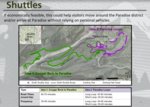

Visitors to the ever-popular Paradise area at Mount Rainier National Park might have a new transportation option in the coming decade.
The National Park Service is in early consideration to look into funding infrastructure for a segmented bus shuttle system that would take visitors up to the 5,400-foot elevation visitor center, which plays host to sight-seeing and recreation.
This option is being considered among other improvements as part of the National Park’s three-phase Visitor Use Management Plan for the Nisqually-to-Paradise corridor. The plan looks to develop strategies to reduce congestion and traffic, improve visitors’ experiences at the park and preserve the history and environment along the most used corridor in Mount Rainier National Park.
The corridor’s Visitor Use Management Plan is currently in the second phase where National Park staff are considering potential comprehensive strategies while requesting feedback from the public.
Last summer, staff solicited suggestions from more than 1,000 visitors about ideas to help the corridor. Highlighted issues from those surveys included entrance station lines, roadway and parking lot congestion, impacts to alpine meadows, staffing levels and a lack of facilities and services.
National Park staff told the public during a virtual planning meeting last Thursday that they were considering the option of a shuttle system. Two routes were being considered: either a route from Cougar Rock Campground to the Paradise visitor center, or a route along lower Paradise Valley Road that would loop around the Paradise area.
Staff say both route ideas would help to reduce congestion and traffic at the visitor center, which is often overflowing with cars during warm summer weekends. Often during those times, there will be more people parked along Paradise Valley Road than at any other lot in the park, said Rachel Collins, project manager with National Park Service.
“This one is an investment,” she said. “And there is a limited amount of park resources to invest in high-cost strategies, and this is one of the higher cost strategies that we’re considering at this time. We want to be really, really thoughtful in how we analyze that option, thoughtful as we consider who would use it and how people would use it to make sure that investment is something people find really desirable and we think would be very effective in mitigating some of the issues.”
While shuttles might be effective at limiting the number of cars parked alongside high-traffic park roads, staff acknowledged the proposed routes would be a large time commitment for passengers.
A round trip on the longest route (Cougar Rock) would run 70 minutes, though possibly longer, and shuttle frequency on either route would run 20 to 40 minutes. For comparison, shuttles at Zion National Park — which sees more than 6.3 million riders annually — arrive at the visitor center every six to 10 minutes, though the buses drive on shorter shuttle-only scenic roads.
“I think another key component to think about here is that the Nisqually road — the road to Paradise — was one of the first roads established in the National Park Service system. And, at the risk of sounding cliche, it was meant to be driven,” Collins said. “To some extent, we changed the nature of that roadway when we take private vehicles off of it, and the cultural resources and as part of the Mount Rainier story.”
Having the National Park Service operating a parkwide shuttle service, Collins said, would just not be feasibly or financially possible without partners. It also wouldn’t be realistic to go shuttle-only on all park roads, especially since Mount Rainier sees more than 2 million visitors each year, according to its website.
Shuttle systems are also rarely ever implemented for national parks unless conditions and the environment make them possible.
Visit Rainier, a nonprofit independent of the park, says most visitors without their own vehicle opt for vehicle rental companies and private group tours. But even those can get costly and demand can be high.
There are currently no public shuttles operated in the park.
In addition to the shuttle idea, National Park staff are also considering strategies including an online reservation or timed-entry system, stimulating winter visitation and recreation to offload summer visitation, making improvements to Cougar Rock picnic area and Paradise and opening up part of Westside Road, which is currently closed to private vehicles.
Each of these will be evaluated based on their viability, feasibility and desirability.
Some of these strategies may help to allure people away from Paradise and to lesser-known areas along the Nisqually corridor. A reservation system for entrance into certain portions of the park would also help parking at the upper roads at Paradise.
National Park Service staff will be soliciting feedback on these strategies from now through Sept. 14. Visit www.parkplanning.nps.gov to provide feedback and learn more about the proposed strategies.
“Visitors currently experience wait times of more than an hour to enter the park through the Nisqually Entrance Station on busy days, causing congestion both inside and outside of the park. Roadway congestion also occurs within the park at popular trailheads, which leads to parking in undesignated areas and pedestrian safety concerns due to limited roadway visibility,” the plan’s website reads.